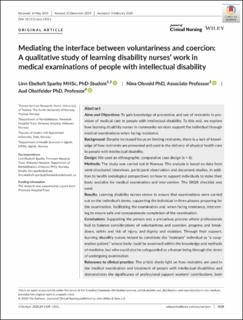Mediating the interface between voluntariness and coercion: a qualitative study of learning disability nurses` work in medical examinations of people with intellectual disability
Peer reviewed, Journal article
Published version
Permanent lenke
https://hdl.handle.net/11250/2722715Utgivelsesdato
2020Metadata
Vis full innførselSamlinger
- Artikler / Articles [1186]
- Publikasjoner fra CRIStin [1133]
Sammendrag
Aims and Objectives: To gain knowledge of prevention and use of restraints in provision of medical care to people with intellectual disability. To this end, we explore how learning disability nurses in community services support the individual through medical examinations when facing resistance.
Background: Despite increased focus on limiting restraints, there is a lack of knowledge of how restraints are prevented and used in the delivery of physical health care to people with intellectual disability.
Design: We used an ethnographic comparative case design (n = 6).
Methods: The study was carried out in Norway. The analysis is based on data from semi-structured interviews, participant observation and document studies, in addition to health sociological perspectives on how to support individuals to make their body available for medical examination and intervention. The SRQR checklist was used.
Results: Learning disability nurses strove to ensure that examinations were carried out on the individual's terms, supporting the individual in three phases: preparing for the examination, facilitating the examination and, when facing resistance, intervening to ensure safe and compassionate completion of the examination.
Conclusions: Supporting the person was a precarious process where professionals had to balance considerations of voluntariness and coercion, progress and breakdown, safety and risk of injury, and dignity and violation. Through their support, learning disability nurses helped to constitute the “resistant” individual as “a cooperative patient,” whose body could be examined within the knowledge and methods of medicine, but who could also be safeguarded as a human being through the strain of undergoing examination.
Relevance to clinical practice: The article sheds light on how restraints are used in the medical examination and treatment of people with intellectual disabilities and demonstrates the significance of professional support workers’ contributions, both in facilitating safe and efficient medical care and in ensuring the least restrictive and most compassionate care possible.
